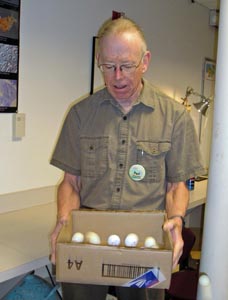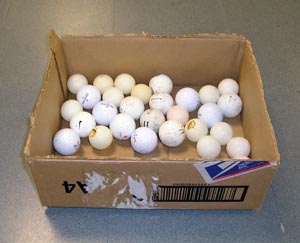Isotope Evaporation

Model the Evaporation of water vapor containing different isotopes of oxygen using heavy and light balls in a box.
Material
An open top, shallow box, 10 cm or so deep,
10 golf balls
10 ping-pong balls
Construction
Place the balls into the box.

To Do and Notice
Shake the box gently. The motion of the balls indicates the temperature of the liquid being modeled in this activity.
Increase the amplitude of your shaking, notice that a few balls evaporate from the liquid and leave the box.
Shake the box more violently and notice that more balls evaporate.
Notice that many more ping-pong balls evaporate than golf balls.
What's Going On?
The golf balls represent the heavy isotope Oxygen-18, 18O
The ping-pong balls represent the lighter isotope Oxygen-16, 16O
At a given temperature in a liquid the kinetic energy of motion of the molecules is equally shared on the average.
Since kinetic energy is 1/2mv^2 where m is the mass of the molecule and v is its velocity, then the water molecules containing the less massive 16O must be moving faster than the molecules containing the more massive 18O.
These faster moving water molecules containing 16O evaporate more quickly than the ones containing the heavier 18O.
The difference in the evaporation rate increases as the temperature decreases, so water vapor over a cooler ocean is richer in O16 than water vapor over a warmer ocean.
Conversely, water liquid in a colder ocean becomes enriched in 18O.
So What?
The water vapor drifts in the atmosphere to antarctica where it freezes into snowflakes which fall onto the surface and become trapped year after year in layers of glacial ice.
So, by looking at the oxygen isotopes in glacial ice we can find the temperature of the surface of the oceans in the past.
Shelled organisms use oxygen to make their carbonate shells , CaCO3. The shells of long dead organisms buried in sediment cores also show oxygen isotope ratios that depend on the surface temperature of the ocean.
So by looking at shells in sediment cores we can also measure the temperature of the oceans in the past.